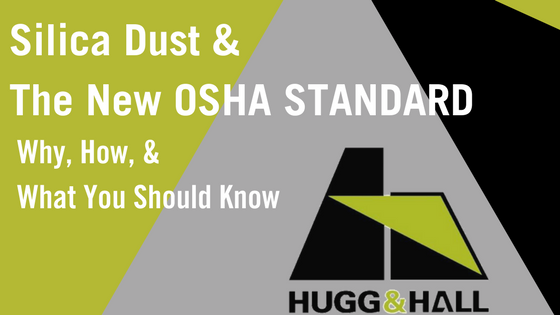
Silica Dust And The New OSHA Standard

The Occupational Safety and Health Administration (OSHA) has enacted new standards to protect workers from the dangers of silica dust. We understand that contractors, equipment companies and other impacted groups may not be enthusiastic about more regulation and procedural changes, so we’ve assembled some information to assist you through the adjustment and to provide you with the information and resources that you need.
1. What is Changing Because of the New Regulations
Silica is a common crystallized mineral found in the ground. Sand, stone, concrete and mortar all contain crystalline silica. Crystalline silica is also used to make products including: glass, pottery, ceramics, brick and artificial stone. Particles of respirable crystalline silica is created when cutting, sawing, grinding, drilling and crushing stone, rock, concrete, brick, block and mortar. Workers are exposed to crystalline silica, or silica dust, when conducting activities such as sandblasting, sawing brick or concrete, sanding or drilling into concrete walls, grinding mortar, manufacturing brick, concrete blocks, stone countertops or ceramic products, hydraulic fracturing, foundry work and cutting or crushing stone. About 2.3 million people in the U.S. are exposed to silica at work, according to OSHA.
Workers exposed to silica dust particles are at an increased risk of developing the following diseases, according to OSHA:Silicosis, an incurable lung disease that can lead to disability and death.
- Silicosis, an incurable lung disease that can lead to disability and death.
- Lung cancer.
- Chronic obstructive pulmonary disease (COPD).
- Kidney disease.
2. What is Changing Because of the New Regulations
The new standards may seem daunting but we will try to simplify them as much as possible. Basically, responding to the dangerous effects of silica dust, OSHA has issued two new respirable crystalline silica standards: One for construction and one for general industry/maritime. The construction standard began implementation on September 23 and the general industry/maritime standard will begin implementation on June 23, 2018.
Simply put, there are three paths to complying to the new construction standard which requires workers not be exposed to more than 50 µg/m3 of silica dust in an eight-hour period (this is down from the prior standard of 250 µg/m3).
- The first path is through complying via the standardized Table 1 method, which is a prescribed method of controls that is commercially available and easy to use. Please find a copy of the standardized Table 1 here: https://www.osha.gov/silica/SilicaConstructionRegText.pdf.
- The second path is via performance or objective data to document that workers are in compliance with the 50 µg/m3 exposure limit.
- The third requires periodically testing for a particular application to validate if the user falls under the permissible 50 µg/m3 exposure limit.
Additional requirements include the below. Please see OSHA 29 CFR 1926.1153 for a full listing of requirements.
- Keeping a written exposure control plan.
- Designating a key competent person.
- Compliant worker training
- .Restriction of housekeeping practices.
- Written records of trainings, control plans, etc.
There are a few additional methods for controlling dust inhalation, as recommended by OSHA:
- Use concrete saws with a built-in system which applies water to the saw blade to limit the amount of silica dispersed in the air.
- Use ventilation and vacuum systems with a hood surrounding the grinding wheel and suction capabilities which captures dust at the grinding point. Other features that should be included are: a 1.5-to-2 in.-diameter vacuum exhaust hose, a high-efficiency particulate air filter (which are recommended as an alternative to compressed air systems while cleaning surfaces) and a static pressure gauge.
- Use a smaller wheel or less aggressive tool and use chipping versus grinding features to reduce silica dust exposure.
- Use ground-fault circuit interrupters and sealable electrical connectors for electrical tools and equipment.
If none of these methods can be used, workers will be required to use respiratory protection and be trained on the appropriate use and maintenance of the respiratory systems used.
3. The Effect of the Silica Regulations
A major effect of these new regulations will be updated inventory by stores and rental agencies. The following products may gradually become available by stores in order to assist clients/contractors with OSHA compliance.
- Products featuring wet solution systems which provide water delivery for limited silica exposure.
- Suitable respirators.
- Vacuums featuring: 99 percent filter efficiency, filter-cleaning mechanisms and 25 cfm of suction per inch of blade diameter for hand-held grinders.
- Dust collecting accessories including: shrouds, hollowed-out drill bits, vacuum adapters and spare vacuum hoses.
- Supporting information with products to assist with compliance procedures.
While the financial effects of the new regulations are unclear, it’s possible that product prices may increase to adjust features for OSHA-compliance. However, the full financial effects are unclear at this early-stage. Although adjusting to new regulations can be burdensome, the safety of workers is the foremost priority and there are many resources available to companies/groups.
Back to News
Subscribe and unlock cutting-edge equipment insights, trends and tips!
Subscribe